Use the following information to answer the questions below.
Two true-breeding stocks of pea plants are crossed. One parent
has red, axial flowers and the other has white, terminal flowers; all
F1 individuals have red, axial flowers. The genes for flower color and
location assort independently.
Among the F2 offspring, what is the probability of
plants with white axial flowers?
3/16
Which of the following provides an example of epistasis?
In rabbits and many other mammals, one genotype (cc) prevents any fur color from developing.
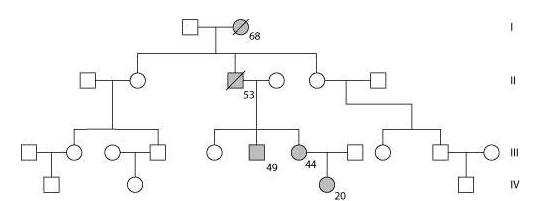
Use the following pedigree (Figure 14.3) for a family in which
dark-shaded symbols represent individuals with one of the two major
types of colon cancer. Numbers under the symbols are the individual's
age at the time of diagnosis.
Figure 14.3
What is the genotype of the deceased individual in
generation II?
heterozygous for a gene for colon cancer
Use the following information to answer the questions below.
Radish flowers may be red, purple, or white. A cross between a
red-flowered plant and a white-flowered plant yields all-purple
offspring. The part of the radish we eat may be oval or long, with
long being the dominant characteristic.
In the F2 generation of the above cross, which of the
following phenotypic ratios would be expected?
6:3:3:2:1:1
Use the information given here to answer the following questions.
Feather color in budgies is determined by two different genes,
Y and B, one for pigment on the outside and one for
the inside of the feather. YYBB, YyBB, or
YYBb is green; yyBB or yyBb is blue; YYbb
or Yybb is yellow; and yybb is white.
A blue budgie is crossed with a white budgie. Which of the
following results is not possible?
green and yellow offspring
Use the following information to answer the questions below.
A woman who has blood type A positive has a daughter who is type
O positive and a son who is type B negative. Rh positive is a trait
that shows simple dominance over Rh negative and is designated by the
alleles R and r, respectively. A third gene for the
MN blood group has codominant alleles M
and N.
If both children are of blood type M, which of the following
is possible?
Each parent is either M or MN.
Two plants are crossed, resulting in offspring with a 3:1 ratio for a particular trait. What does this suggest?
that the parents were both heterozygous for a single trait
Use the information given here to answer the following questions.
Feather color in budgies is determined by two different genes,
Y and B, one for pigment on the outside and one for
the inside of the feather. YYBB, YyBB, or
YYBb is green; yyBB or yyBb is blue; YYbb
or Yybb is yellow; and yybb is white.
Two blue budgies were crossed. Over the years, they produced
22 offspring, 5 of which were white. What are the most likely
genotypes for the two blue budgies?
yyBb and yyBb
Which of the following describes the ability of a single gene to have multiple phenotypic effects?
pleiotropy
Use the following information to answer the questions below.
A woman who has blood type A positive has a daughter who is type
O positive and a son who is type B negative. Rh positive is a trait
that shows simple dominance over Rh negative and is designated by the
alleles R and r, respectively. A third gene for the
MN blood group has codominant alleles M
and N.
Which of the following is a possible genotype for the mother?
IAi
Use the following information to answer the questions below.
Radish flowers may be red, purple, or white. A cross between a
red-flowered plant and a white-flowered plant yields all-purple
offspring. The part of the radish we eat may be oval or long, with
long being the dominant characteristic.
The flower color trait in radishes is an example of which of the following?
incomplete dominance
What do we mean when we use the terms monohybrid cross and dihybrid cross?
A dihybrid cross involves organisms that are heterozygous for two characters and a monohybrid cross involves only one.
Use the following information to answer the questions below.
A woman who has blood type A positive has a daughter who is type
O positive and a son who is type B negative. Rh positive is a trait
that shows simple dominance over Rh negative and is designated by the
alleles R and r, respectively. A third gene for the
MN blood group has codominant alleles M
and N.
Which of the following is a possible phenotype for the father?
B positive
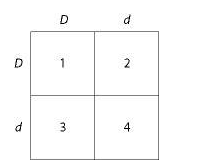
Use Figure 14.1 and the following description to answer the questions below.
In a particular plant, leaf color is controlled by gene locus
D. Plants with at least one allele D have dark green
leaves, and plants with the homozygous recessive dd genotype
have light green leaves. A true-breeding dark-leaved plant is crossed
with a light-leaved one, and the F1 offspring is allowed to
self-pollinate. The predicted outcome of the F2 is
diagrammed in the Punnett square shown in Figure 14.1, where 1, 2, 3,
and 4 represent the genotypes corresponding to each box within the square.
Figure 14.1
Which of the plants will be true-breeding?
1 and 4 only
A sexually reproducing animal has two unlinked genes, one for head shape (H) and one for tail length (T). Its genotype is HhTt. Which of the following genotypes is possible in a gamete from this organism?
HT
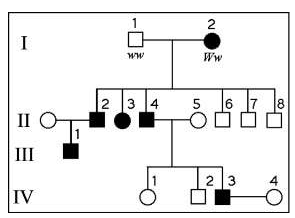
The following questions refer to the pedigree chart in Figure 14.2
for a family, some of whose members exhibit the dominant trait,
W. Affected individuals are indicated by a dark square or circle.
Figure 14.2
What is the genotype of individual II-5?Correct!
ww
Given the parents AABBCc x AabbCc, assume simple
dominance for each trait and independent assortment. What proportion
of the progeny will be expected to phenotypically resemble the first parent?
3/4
Mendel accounted for the observation that traits which had disappeared in the F1 generation reappeared in the F2 generation by proposing that
traits can be dominant or recessive, and the recessive traits were
obscured by the dominant ones in the F1.
Mendel's observation of the segregation of alleles in gamete formation has its basis in which of the following phases of cell division?
anaphase I of meiosis
Mendel's second law of independent assortment has its basis in which of the following events of meiosis I?
alignment of tetrads at the equator
Use the following information to answer the questions below.
Radish flowers may be red, purple, or white. A cross between a
red-flowered plant and a white-flowered plant yields all-purple
offspring. The part of the radish we eat may be oval or long, with
long being the dominant characteristic.
If true-breeding red long radishes are crossed with
true-breeding white oval radishes, the F1 will be expected
to be which of the following?
purple and long
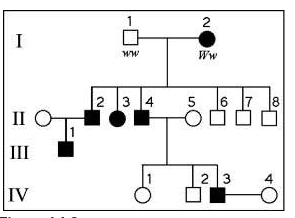
The following questions refer to the pedigree chart in Figure 14.2
for a family, some of whose members exhibit the dominant trait,
W. Affected individuals are indicated by a dark square or circle.
Figure 14.2
What is the probability that individual III-1 is Ww?
1
Black fur in mice (B) is dominant to brown fur (b).
Short tails (T) are dominant to long tails (t). What
fraction of the progeny of crosses BbTt x BBtt
will be expected to have black fur and long tails?
1/2
Hydrangea plants of the same genotype are planted in a large flower garden. Some of the plants produce blue flowers and others pink flowers. This can be best explained by which of the following?
environmental factors such as soil pH
Use the following information to answer the questions below.
Tallness (T) in snapdragons is dominant to dwarfness
(t), while red (R) flower color is dominant to white
(r). The heterozygous condition results in pink (Rr)
flower color.
If snapdragons are heterozygous for height as well as for
flower color, a mating between them will result in what ratio?
6:3:3:2:1:1
Cystic fibrosis affects the lungs, the pancreas, the digestive system, and other organs, resulting in symptoms ranging from breathing difficulties to recurrent infections. Which of the following terms best describes this?
pleiotropy
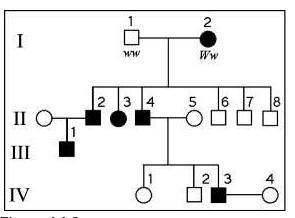
The following questions refer to the pedigree chart in Figure 14.2
for a family, some of whose members exhibit the dominant trait,
W. Affected individuals are indicated by a dark square or circle.
Figure 14.2
What is the likelihood that the progeny of IV-3 and
IV-4 will have the trait?
50%
When crossing an organism that is homozygous recessive for a single trait with a heterozygote, what is the chance of producing an offspring with the homozygous recessive phenotype?
50%
Use the following information to answer the questions below.
Tallness (T) in snapdragons is dominant to dwarfness
(t), while red (R) flower color is dominant to white
(r). The heterozygous condition results in pink (Rr)
flower color.
A dwarf, red snapdragon is crossed with a plant homozygous
for tallness and white flowers. What are the genotype and phenotype of
the F1 individuals?
TtRr-tall and pink
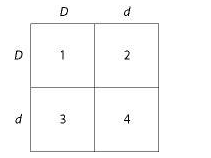
Use Figure 14.1 and the following description to answer the questions below.
In a particular plant, leaf color is controlled by gene locus
D. Plants with at least one allele D have dark green
leaves, and plants with the homozygous recessive dd genotype
have light green leaves. A true-breeding dark-leaved plant is crossed
with a light-leaved one, and the F1 offspring is allowed to
self-pollinate. The predicted outcome of the F2 is
diagrammed in the Punnett square shown in Figure 14.1, where 1, 2, 3,
and 4 represent the genotypes corresponding to each box within the square.
Figure 14.1
Which of the boxes correspond to plants with a
heterozygous genotype?
2 and 3
In the cross AaBbCc x AaBbCc, what is the probability of producing the genotype AABBCC?
1/64
Which of the following is an example of polygenic inheritance?
skin pigmentation in humans
Use the following information to answer the questions below.
Drosophila (fruit flies) usually have long wings (+) but
mutations in two different genes can result in bent wings
(bt) or vestigial wings (vg).
If a homozygous bent wing fly is mated with a homozygous
vestigial wing fly, which of the following offspring would you expect?
all +bt +vg heterozygotes
Marfan syndrome in humans is caused by an abnormality of the connective tissue protein fibrillin. Patients are usually very tall and thin, with long spindly fingers, curvature of the spine, sometimes weakened arterial walls, and sometimes ocular problems, such as lens dislocation. Which of the following would you conclude about Marfan syndrome from this information?
It is pleiotropic.
Use the following information to answer the questions below.
A woman who has blood type A positive has a daughter who is type
O positive and a son who is type B negative. Rh positive is a trait
that shows simple dominance over Rh negative and is designated by the
alleles R and r, respectively. A third gene for the
MN blood group has codominant alleles M
and N.
Which of the following is a possible partial genotype for the son?
IBi
In certain plants, tall is dominant to short. If a heterozygous plant is crossed with a homozygous tall plant, what is the probability that the offspring will be short?
0
In cattle, roan coat color (mixed red and white hairs) occurs in the heterozygous (Rr) offspring of red (RR) and white (rr) homozygotes. Which of the following crosses would produce offspring in the ratio of 1 red:2 roan:1 white?
roan x roan
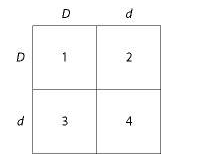
Use Figure 14.1 and the following description to answer the questions below.
In a particular plant, leaf color is controlled by gene locus
D. Plants with at least one allele D have dark green
leaves, and plants with the homozygous recessive dd genotype
have light green leaves. A true-breeding dark-leaved plant is crossed
with a light-leaved one, and the F1 offspring is allowed to
self-pollinate. The predicted outcome of the F2 is
diagrammed in the Punnett square shown in Figure 14.1, where 1, 2, 3,
and 4 represent the genotypes corresponding to each box within the square.
Figure 14.1
Which of the boxes marked 1-4 correspond to plants
with dark leaves?
1, 2, and 3
Use the following information to answer the questions below.
Drosophila (fruit flies) usually have long wings (+) but
mutations in two different genes can result in bent wings
(bt) or vestigial wings (vg).
If flies that are heterozygous for both the bent wing gene
and the vestigial wing gene are mated, what is the probability of
offspring with bent wings only?
3/16